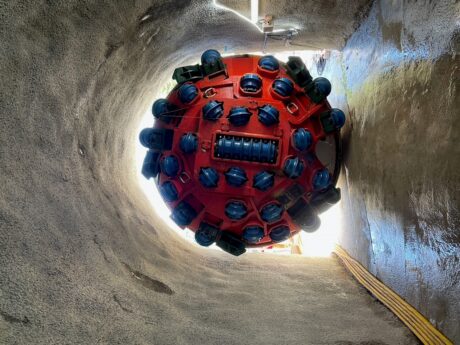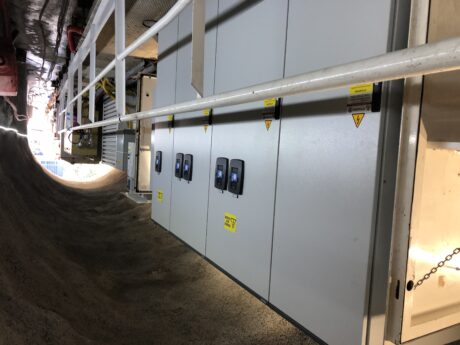Maximum of the power for excavating uphill tunnels. The powerful Danfoss inverters of the VACON® NXP family drive the Tunnel Boring Machine (TBM) that contractor Cogeis from Italy is using to dig a tunnel with a 22% slope to serve a new hydroelectric power plant in the Alpe d’Huez area, placed in France, very near to the border with Italy
The energy transition requires to make the most out from the natural resources of each territory, without having to overturn it. This is the philosophy adopted to carry out an important hydroelectric generation project commissioned by Compagnie Nationale du Rhône (CNR), which obtained the concession to exploit the waters of the La Sarenne stream, in the Alpe d’Huez area.
It is an innovative project also due to its ability to integrate perfectly into the territory, thanks to almost entirely underground systems, but which to be built requires the adoption of cutting-edge construction techniques, capable of overcoming the challenges posed by working. in the difficult alpine environment and without interfering with the activities of a region with a tourist vocation.

One of the main works to be carried out as part of the La Sarenne project is an underground tunnel 2700 m long, which climbs with a slope of 22% to the outlet near the intake works, where the water of the stream is derived
La Sarenne tunnel
One of the main works to be carried out as part of the La Sarenne project is an underground tunnel 2700 m long, which climbs with a slope of 22% to the outlet near the intake works, where the water of the stream is derived.
The underground tunnel, with a diameter of 4.2 m, has a dual function. The first section upstream, for about 800 m, will constitute the water reservoir, which will then fill the entire volume excavated in contact with the walls of the tunnel. The second section of the tunnel, separated from the first by a bulkhead, will instead serve to house the penstock, which will carry the pressurized water downstream.
The underground insertion of both the tank and the penstock will thus make the system practically “invisible” from the outside and perfectly integrated into the territory.
As part of the consortium of companies entrusted with the realization of the La Sarenne project, the construction of the tunnel inside the mountain falls under the responsibility of Cogeis, an Italian general contractor with a strong international vocation that has gained consolidated experience in the construction of civil infrastructures in complex work environments.
For over twenty years Cogeis has refined the construction techniques of infrastructures for the transport of water and gas through mechanized excavation and for La Sarenne project it has opted for the use of a used TBM of which it has recently acquired full ownership, completely renovating it purpose.
A refurbished TBM
Paolo Bresciano, head of the revision project of the TBM acquired by Cogeis, tells us, «We were well aware of not only having to overhaul the machine, but also having to modify it in many of its mechanical, hydraulic and, above all, electrical parts. Each mechanized excavation project we faced poses different challenges and the La Sarenne project is no exception.
In this case, not only we had to dig uphill, with a considerable slope that significantly impacts the distribution of the forces involved in a 600-ton machine, but also because of the very limited space available at the access points to the construction site, about 25 m, we also had to invent a suitable way of assembling a 176 m long machine. There were many aspects to deal with, such as those of the compartmentalization to protect against the possible presence of asbestos in the rocks, but certainly the ‘electrical’ ones led to a total renewal of the equipment, which allowed us to obtain performance and flexibility far superior to those possible with the original configuration.»
The TBM purchased by Cogeis used a configuration of 5 motors of 225 kW each, connected to a gearbox through clutches, to drive the rotating head.
Bresciano explains: «The five motors could only be set by switching the poles at two different speeds. Furthermore, every time the motors to drive the cutter were started, a great mechanical stress was generated, both on the gearboxes and on the entire mechanical structure, which we could not afford to tolerate when tackling a demanding excavation project such as the La Sarenne tunnel. However, we wanted to keep the original engines, designed specifically for the size of the TBM. The solution was therefore to think of a new generation solution with inverter.»
Through the local DrivePro® Service Partner, Gatta Srl, Cogeis contacted Danfoss to study a suitable solution for the renewal of the electrical system.
Many advantages with drives
The solution proposed by Gatta Srl and Danfoss is based on the VACON® NXP Liquid Cooled drives family, which have a very simple and effective load sharing management capability.
Paolo Bresciano confirms: «Thanks to the inverter control, any discontinuity of load on the motors due to the dynamic variations of the rock conditions, no longer generates important mechanical stresses, but electrical ones, which are rebalanced autonomously by the Danfoss control system, capable of appropriately manage the torque differences absorbed by the individual motors.

Furthermore, the inverter control allows us to choose the rotation speed of the cutter with maximum flexibility, based on the expected conditions of the rock in the various stages of excavation progress. Last but not least, we have the possibility to reconfigure the system instantly if we need to stop a motor or an inverter for maintenance, without any significant impact on the productivity of the machine.»
Joint planning and tailor-made services
The design of the new cutter drive system was carried out in close collaboration between the technicians of Cogeis, the partner Gatta Srl and the engineers of the Project Solutions department from Danfoss Italy.
Paolo Bresciano recalls: «The constraints on space and for the passage of electrical cables and pipelines for liquid cooling were very stringent, so we all shared all our skills. It was a very satisfying job, because we found ourselves, each in their own role, ‘speaking the same language’, which also allowed us to respect the very stringent execution times for this realization. In fact the start of the machine overhaul project dates back to the end of January 2021 and at the end of August 2021 we dug the first rock: an extraordinary success for us.»
To optimize the driving of the motors, originally not designed for use with inverters, specially designed dU/ dt filters were integrated, while the construction of the electrical panel was followed by the Italian Danfoss team, which delivered the entire equipment ready to be installed on the TBM. In addition, Danfoss also provided DrivePro® Extended Warranty services, which provides a warranty extension of up to 6 years, the largest in the industry.
Renewable energy at the end of the tunnel
The complex La Sarenne project is currently in full swing and excavation of the tunnel has started under the best auspices. The Cogeis TBM advances with the thrust of Danfoss inverters and, when it will see the light again, it will be extracted from the top and disassembled to be ready to face new challenges; and thanks to the flexibility of the inverter solution, it can be quickly ready to go to a new excavation site.
At the end of the installation of hydroelectric generation equipment, with a power of 11 MW for an estimated annual production of 36 GWh, from 2024 CNR, an amount of 100% renewable energy will be ready to feed into the grid, equivalent to the consumption of 16,000 families.
This project represents a new example of how the Danfoss technologies and skills and its customers, translate the concept of sustainable transformation into action.





